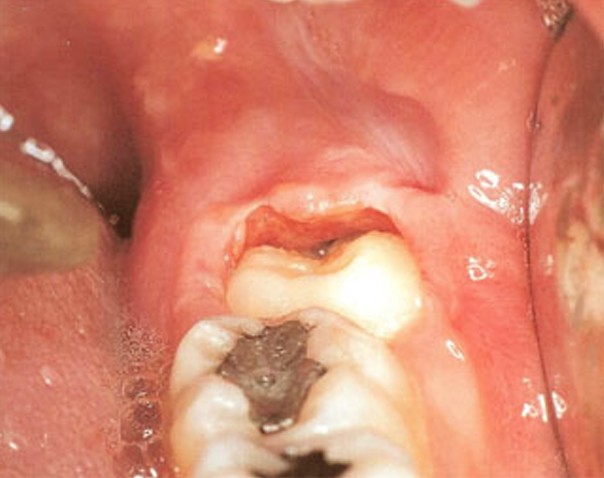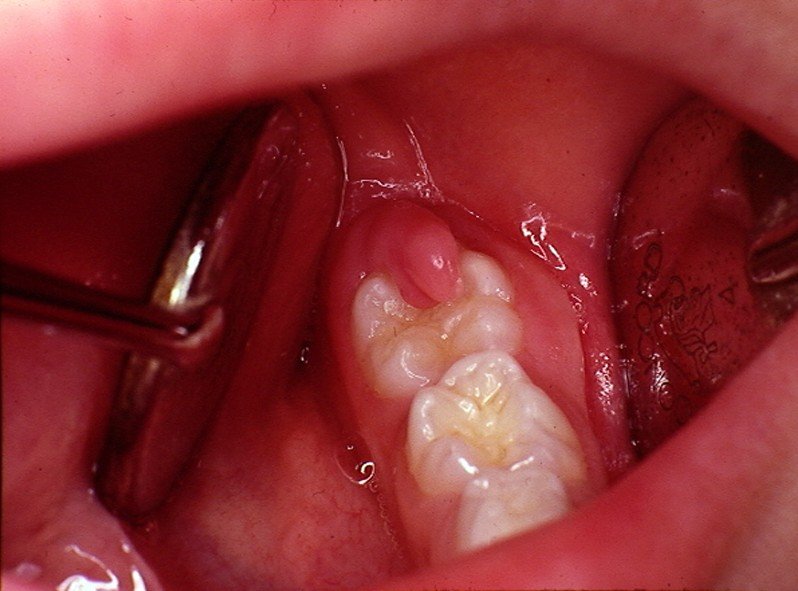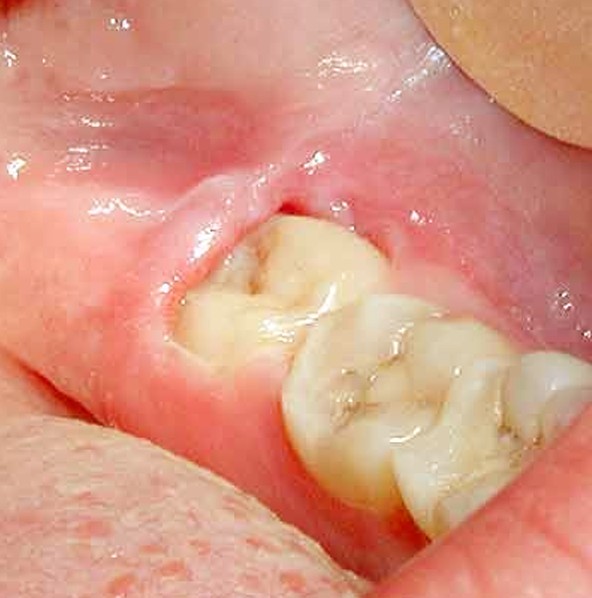Pericoronitis
Last reviewed by Dr. Raj MD on January 12th, 2022.
What is Pericoronitis?
This medical condition is a common dental disorder in which your gum tissue around your wisdom teeth becomes infected and swollen. Your wisdom teeth normally erupt between the ages of seventeen and twenty-four. This is the third and last set of molars a person gets. Getting pericoronitis is one of the main reasons that you have your wisdom teeth extracted.
Pericoronitis Symptoms
- Pain
- In the area of the affected tooth the gum tissue is swollen. It may be difficult to bite down on anything comfortably without the swollen tissue being caught between your teeth. The swollen gum tissue can progress to a knob-like mass of tissue that is very painful especially when you open and close your mouth or chew.
- Bad breath that can be caused by bacteria and food that becomes trapped under the gum flap.
- Stiffness in the jaw.
- Pus discharge near the tooth from the gum.
- A bad taste or smell in your mouth caused by the pus that is leaking from the gums.
There can also be more serious symptoms that can include:
- Throbbing pain that is severe.
- Lymph nodes in the neck under the chin become swollen.
- Having muscle spasms in the jaw.
- On the affected side of your face there is swelling.
- Having difficulty in opening your mouth.
- Fever
- Having difficulty in swallowing food.
Pericoronitis Causes
Pericoronitis happens when your wisdom teeth only partially break through your gum, allowing an opening for bacteria to get around the tooth, causing an infection. This is called impaction. It can happen in other teeth but it is rare to have impaction problems in other teeth so impaction of wisdom teeth is the main teeth involved. The wisdom teeth that are usually affected are the ones in the lower jaw.
In some cases around the tooth, plaque, which is a bacterial film that stays on your teeth after you eat, or food could get caught underneath a flap of gum. If either one stays there your gum can become irritated and cause pericoronitis. Pericoronitis can also be cause by a minor trauma of your gums around the tooth. These minor injuries or trauma can during chewing your teeth could accidentally bite down on the infected gum flap causing more swelling and irritation, causing pericoronitis to develop.
Some other factors that many consider predispose to pericoronitis may include:
- Emotional stress
- Upper respiratory tract infections
- Fatigue
- Menstruation
- The second trimester of pregnancy.
Pericoronitis Treatment
The treatment that is used will depend on the severity of disease and the symptoms. Your dentist may use a combination of treatments. One thing that you should not do is apply heat to the area as it can promote the spread of the infection toward the skin on your face. Some of the treatments that might be used are:
- Improving oral hygiene to keep the area cleaner.
- Rinsing with warm salt water frequently.
- To avoid irritating your gum tissue you should eat a soft diet.
- For temporary pain relief use analgesics.
- If the dentist does not immediately take out the tooth causing the problem they may do an excision of the flap of gum tissue.
- If an abscess has developed the dentist may drain it.
- Extraction of the tooth causing the problem, which should be done after the dentist gets the infection under control so it does not spread.
Usually pericoronitis symptoms can be relieved with treatment in about seven days. It will most likely return if the bacteria and food keep building up under the gum and the tooth is still partially impacted and not removed. The only permanent solution is to remove the impacted wisdom tooth.
Antibiotics
For the infection the dentist may use antibiotic therapy which is usually penicillin. If the case of pericoronitis is severe and the infection and swelling has spread to the neck the dentist may admit you to the hospital to be treated with intravenous antibiotics.
Home remedies
If there is mild discomfort and pain you can use some simple home remedies but if pericoronitis is very painful you should have it treated only by a dentist because the tooth will need to be removed, usually surgically.
Some home remedies that can be used include:
- Apply clove oil to the affected area. Soak a piece of cotton cloth with a few drops of the oil and place it near the impacted tooth for at least an hour. Clove oil has natural anti-inflammatory properties that will help to reduce the inflammation in the gums and help to decrease the pain.
- Camphor – in a piece of cotton cloth wrap a small piece of camphor and put it near the inner lining of your cheek next to the wisdom tooth that is impacted. The camphor will release juice that will have a numbing effect on your painful gums. You need to keep it inside your mouth until the camphor has dissolved completely.
- Massage your cheek near the impacted wisdom tooth with an ice cube. Put it in a small wash cloth and rub it over your cheek for about five minutes. The extreme cold temperature will help to reduce the swelling and have a soothing effect on your pain.
- You can also use over-the-counter oral numbing gel and apply it topically on the inflamed part of your gum around the impacted wisdom tooth. Once this is applied you should not feel any pain in your gum for awhile. You will need to periodically reapply it.
- Use a medicated mouthwash to help control the infection and floss to help remove food particles that are stuck in between the teeth after brushing. When brushing your teeth pay special attention to the area around your impacted tooth.
Using these home remedies will help with the pain and swelling until you can get in to see your dentist to have the tooth extracted.
Pericoronitis Pictures
Photos, Images and Pictures collection of Pericoronitis…



